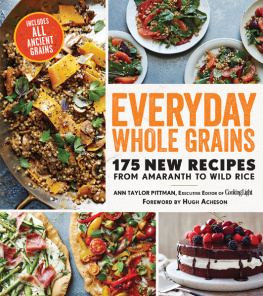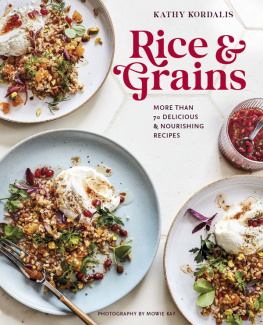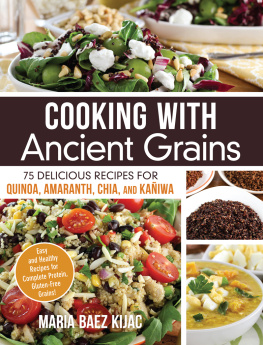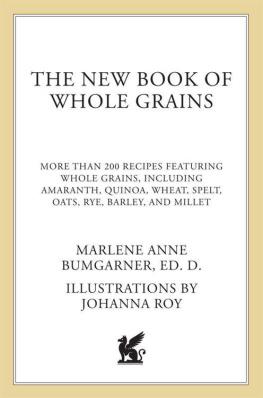CONTENTS

EVERYDAY
WHOLE GRAINS
175 NEW RECIPES
FROM AMARANTH TO WILD RICE
ANN TAYLOR PITTMAN, E XECUTIVE E DITOR OF Cooking light
F OREWORD BY H UGH A CHESON


2016 Time Inc. Books
Published by Oxmoor House, an imprint of Time Inc. Books
225 Liberty Street, New York, NY 10281
Cooking Light is a registered trademark of Time Inc. Lifestyle Group.
All rights reserved. No part of this book may be reproduced in any form or by any means without the prior written permission of the publisher, excepting brief quotations in connection with reviews written specifically for inclusion in magazines or newspapers, or limited excerpts strictly for personal use.
Senior Editor: Betty Wong
Contributing Writer: Mindy Hermann
Editorial Assistant: Nicole Fisher
Assistant Project Editor: Melissa Brown
Designers: Amy Bickell, Allison Chi
Executive Photography Director: Iain Bagwell
Photographer: Hlne Dujardin
Senior Photo Stylists: Kay E. Clarke, Mindi Shapiro Levine
Food Stylists: Nathan Carrabba, Victoria E. Cox
Test Kitchen Manager: Alyson Moreland Haynes
Senior Recipe Developer and Tester: Callie Nash
Recipe Testers: Julia Levy, Karen Rankin
Assistant Production Director: Sue Chodakiewicz
Senior Production Manager: Greg A. Amason
Copy Editors: Jacqueline Giovanelli, Dolores Hydock
Proofreader: Adrienne Davis
Indexer: Mary Ann Laurens
Fellows: Jessica Baude, Rishon Hanners, Olivia Pierce, Mallory Short
eISBN: 978-0-84874-744-2
Library of Congress Control Number: 2015959277
First Edition 2016
Printed in the United States of America
10 9 8 7 6 5 4 3 2 1
Time Inc. Books products may be purchased for business or promotional use. For information on bulk purchases, please contact Ilene Schreider in the Special Sales Department at (212) 522-3985.
We welcome your comments and suggestions about Time Inc. Books. Please write to us at:
Time Inc. Books
Attention: Book Editors
P.O. Box 62310
Tampa, Florida 33662-2310
To Patrick, Daniel, and Connor
FOREWORD
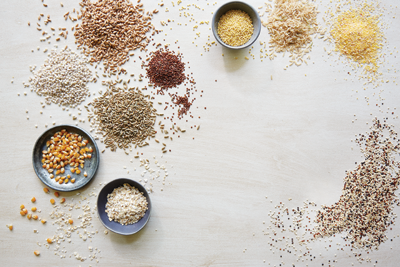
I REMEMBER BARLEY. Thats about it. It was in canned oxtail soup and had a slightly chewy resilience that I loved. But other than that my exposure to grains growing up was pretty much the big three: wheat, corn, and rice. I remember Dad taking some risks with brown rice, and maybe we ate Kashi cereal for a week or two, but really we were like everyone else on our block, on our street, in our town: We didnt know squat about grains.
The age of convenience is something I talk about a lot in an attempt to encourage people to cook food from scratch again. From advances in food preservation to the emergence of the freezer aisle and the creation of highly processed foods laden with preservatives, convenience made strides quickly. These are amazing advances, but we are realizing that bad health and empty calories are part of the price paid for ease. We are at a crucial moment in how we feed ourselves, and it splits us into two camps. Some, lets call them feeders, buy into the idea that sustenance should be supplied, ready to eat, whether from a box, a can, or a fast-food drive-thru. This is food eaten for the simple result of getting full. It has no connection to the soul, with no sign that it once grew out of the ground, coaxed from the land by a real persons hand. But some of us nourishers know that cooking is a pleasure like no other. It feeds us with knowledge, it makes us proud, it provides healthy sustenance to the ones we love, and it gives us a chance to connect with the land around us.
As her contribution to this uprising of nourishers, Ann Pittman has crafted an ode to whole and ancient grains. Grains were once currency, a revered and treasured crop. After a hundred years of refining and homogenizing them for the sake of convenience, we are finally looking outside of the basics of wheat and corn to diversify our diet. Luckily, we have returned to a world where a variety of grains is readily available. Grains that seemed esoteric just a decade ago are gaining prominence again. Spelt, farro, Kamut, barley, and millet are more popular than ever. Unfortunately, until now, we have forgotten one very important thing: how to cook them. In this book, Pittman casts away the mysteries and shifts whole grains back to the center of the plate. She shows why grains have been a staple for thousands of years and demonstrates their importance in all aspects of modern foodways.
How do we get ourselves healthy again? We get back in the kitchen, all of us. We learn to cook through the deep American larder, much of which is grains. Pittman shows us how to do just that, first by defining a variety of grains and second by incorporating those into recipes for breakfast, lunch, and dinner. Even such baked goods as whole-grain cookies and cakes shine with nutty goodness. She instructs the reader on various methods for cooking grains (including popping and frying), arming the home cook with tools typically reserved for the culinary trade. From porridges to breads, smoothies to desserts, casseroles to stews, Everyday Whole Grains clears a path to learn about a vast category of food in a whole new way. So go to your kitchen and make it grain.
Hugh Acheson, chef and author
INTRODUCTION
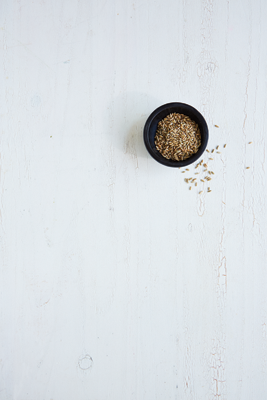
WHOLE AND ANCIENT GRAINS, HUH? Why cant you be working on a meat book, my husband asked when I first told him about this project. I took his skepticism as a challenge and used it to set the bar for this book: Every recipe here should be so good, so convincing , that you want to work it into your everyday life.
Whole grainsmany of which are also ancient grainshave been hot in the American food scene for several years now, with increasing availability at supermarkets through the dedicated work of a handful of companies. Chefs have rediscovered and embraced the beautiful textures and flavors that grains can bring to every course on the menu, from now-almost-ubiquitous farro salads to crunchy popcorn ice cream sundaes. Within months of each other, I enjoyed two amazing restaurant twists on steak tartare that blew my mind: speckled with chewy rye berries at Blackbird in Chicago, and mixed with crunchy fried ancient grains at Catbird Seat in Nashville. In both cases, the grains made the dish. Chefs are having fun with these grains, using their best qualities to provide real delight at the table; home cooks should, too.
There are compelling reasons to do so. The health halo around whole grains continues to blossom during a time when excessive consumption of refined grains (and added sugars) gets pointed at for our nations health woes, including heart disease, weight gain, and diabetes. In a way, whole grains are natures original comfort food, nourishment straight from the earth in perfect balance of protein, fiber, complex carbohydrates, vitamins, and antioxidants, many of which get stripped away in the refining process. The goal for most Americans is to replace much of the refined grains in our diet with more whole grains. And its easier (and tastier) than you might think.
Next page
